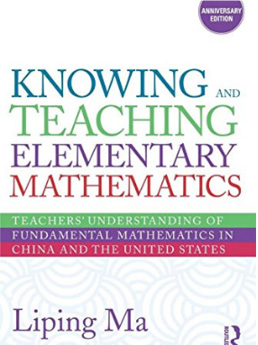Knowing and Teaching Elementary Mathematics: Teachers’ Understanding of Fundamental Mathematics in China and the United States
Liping Ma
Review by: Tia Chambers
Liping Ma has summarized her wide research on teachers’ mathematical knowledge stateside and in China, in the book Knowing and Teaching Elementary Mathematics. Based on the premise that children in China greatly outperform American children in mathematics, Ma set out to examine teachers’ mathematical knowledge in hopes of finding a contributing factor to the disparity. Through recounting clinical interviews taken with teachers in America and China, Ma highlights the differences of mathematical understanding between the two teacher groups. Ma illuminates the various strategies that Chinese teachers use which in turn reflects their deeper knowledge of mathematics.
Ma draws comparisons between the two groups of teachers’ answers about several mathematical strands. Many of the teachers from China employed vocabulary and teaching strategies that promoted deep learning. They reported allowing students to solve a problem on their own and then discuss their strategies to the class, before the teacher introduces formal algorithms. When students utilized manipulatives, they were asked to discuss and argue for their solutions and strategies after the exploration was over. Finally, most of the teachers from China reported making links between deep mathematical concepts while teaching simple algorithms, to help students comprehend the larger mathematical framework that their current work was situated in. On average, only fifteen percent of the American teachers interviewed utilized similar strategies.
Ma suggests that teachers need a deep conceptual understanding of a topic, not just procedural knowledge, in order to ‘empower students with mathematical thinking’ (p. 105). Her findings suggest that most teachers from China hold this understanding, compared to only a small number from the Unites States. Ma argues that without a profound understanding of fundamental mathematics, any strategies or teaching formats utilized will not help students to build their own conceptual understanding. Teachers’ profound understanding in China is developed through several aspects of practice including intensive study of math problems and discussion with other teachers. This book, therefore, is most useful to teacher educators and educational researchers, as Ma does not offer specific strategies or opportunities for teachers to develop content knowledge within this book.

